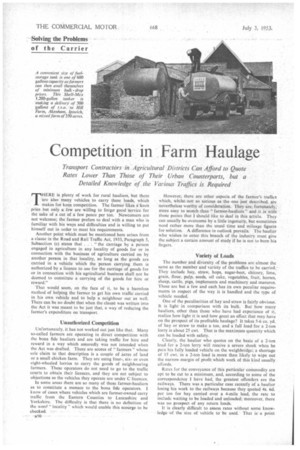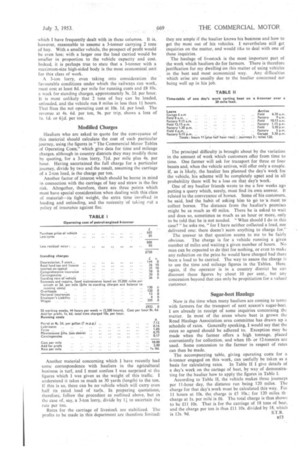Competition in Farm Haulage
Page 108

Page 111

If you've noticed an error in this article please click here to report it so we can fix it.
Transport ContractOrs in Agricultural Districts can Afford to Quote Rates Lower Than Those of Their ,Urban Counterparts, but a Detailed Knowledge of the Various Traffics is Required
THERE is plenty of work for rural hauliers, but there are also many vehicles to carry these loads, which makes for keen competition. The farmer likes a keen price but only a few are willing to forgo good service for the sake of a cut of a few pence per ton. Newcomers are not welcome; the farmer prefers to deal with a man who is familiar with his ways and difficulties and is willing to put himself out in order to meet his requirements.
Another point which must be mentioned here arises from a clause in the Road and Rail Traffic Act, 1933, Paragraph 5, Subsection (c) states that . . . " the carriage by a person engaged in agriculture in any locality of goods for or in connection with the business of agriculture carried on by another person in that locality, so long as the goods are carried in a vehicle which the person carrying, them is authorized by a licence to use for the carriage of goods for or in connection with his agricultural business shall not be deemed to constitute a carrying of the goods for hire or reward."
That would seem, on the face of it, to be a harmless method of helping the farmer to get his own traffic carried in his own vehicle and to help a neighbour out as well. There can be no doubt that when the clause was written into the Act it was meant to be just that, a way of reducing the farmer's expenditure on transport.
Unauthorized Competition
Unfortunately, it has not worked out just like that. Many so-called farmers are operating in direct competition with the bona fide hauliers and are taking traffic for hire and reward in a way which assuredly was not intended when the Act was drafted. There are scores of " farmers " whose sole claim to that description is a couple of acres of land or a small chicken farm. They are using four-, sixor even eight-wheeled lorries to carry the goods of neighbouring farmers. These operators do not need to go to the traffic courts to obtain their licences, and they are not subject to objections as the vehicles they operate are under C licences.
In some areas there are so many of these farmer-hauliers as to constitute a menace to the bona fide operators. I know of cases where vehicles which are farmer-owned carry traffic from the Eastern Counties to Lancashire and Yorkshire_ The difficulty is that there is no definition of the word "locality" which would enable this scourge to be checked.
However, there are other aspects of the farmer's traffics which, whilst not so serious as the one just described, are nevertheless worthy of consideration. They are, fortunately, more easy to scotch than " farmer-hauliers " and it is with those points that I should like to deal in this article. They can usually be overcome by a little ingenuity, but sometimes need rather more than the usual time and mileage figures for solution. A difference in outlook prevails. The haulier who wishes to enter this branch of the industry must give the subject a certain amount of study if he is rim to burn his lingers.
Variety of Loads
The number and diversity of the problems arc almost the same as the number and variety of the traffics to be carried.: They include hay, straw, hops, sugar-beet, chicory, lime, grain, flour, pulp, seeds, oil cake, vegetables, fruit, horses, sheep, cattle, pigs, implements and machinery and manures. These are but a few and each has its own peculiar requirements in respect of the way it is handled and the type of vehicle needed.
One of the peculiarities of hay and straw is fairly obvious. It is light in comparison with its bulk. But how many hauliers, other than those who have had experience of it, realize how light it is and how great an effect that may have on the prospect of its profitable haulage? It takes 5-6 cu. yd. of hay or straw to make a ton, and a full load for a 2-ton lorry is about 25 cwt. That is the maximum quantity which can be loaded with safety. • Clearly, the haulier who quotes on the basis of a 2-ton load for a 2-ton lorry will receive a severe shock when he pus his fully loaded vehicle on the weighbridge; a shortage of 15 cwt. in a 2-ton load is more than likely to wipe out the narrow margin of profit which work of this kind usually affords.
Rates for the conveyance of this particular commodity are apt to be cut to a minimum, and, according to some of the correspondence I have had, the greatest offenders are the railways. There was a particular case recently of a haulier losing his work to the railways because they quoted 4s. 6d. per ton for hay carried over a 4-mile lead, the rate to include waiting to be loaded and unloaded; moreover, there was no prospect of any return loads.
It is clearly difficult to assess rates without some knowledge .of the size of• vehicle to be used. That is a point which I have frequently dealt with in these columns. It is, however, reasonable to assume a 3-tonner carrying 2 tons of hay. With a smaller vehicle, the prospect of profit would be even less; with a larger one the load carried would be smaller in proportion to the vehicle capacity and cost. Indeed, it is perhaps true to state that a 3-tonner with a maximum-size high-sided body is the most economical.unit for this class of work.
A 3-ton lorry, even taking into consideration the favourable conditions under which the railways can work, must cost at least 8d. per mile for running costs and £8 10s. a week for standing charges, approximately 3s. 2d. per hour. It is most unlikely that 2 tons of hay can be loaded, unloaded, and the vehicle run 8 miles in less than 11 hours. That fixes the net operating cost at 10s. Id. per load. The revenue at 4s. 6d. per ton, 9s. per trip, shows a loss of Is. Id. or 61d. per ton.
Modified Charges
Hauliers who are asked to quote for the conveyance of this material should calculate the cost of each particular journey, using the figures in "The Commercial Motor Tables of Operating Costs," which give data for time and mileage charges, although in country districts they may modify these by quoting, for a 3-ton lorry, 71d. per mile plus 4s. per hour. Having ascertained the full charge for a particular journey, divide by two and the result, assuming the carriage of a 2-ton load, is the charge per ton.
Another factor of interest which should be borne in mind in connection with the carriage of hay and straw is the• fire risk, Altogether, therefore, there are three points which must have special consideration when dealing with this class of material-its light weight, the extra time involVed in loading and unloading, and the necessity of taking ent a policy of insurance against fire.
Another material concerning which I have recently had some correspondence with hauliers in the agricultural business is turf, and I must confess I was surprised at the figures which I was given as the weight of this traffic. I understand it takes as much as 30 yards (length) to the ton. If this is so, there can be no vehicle which will carry even half its rated load of turfs.. In preparing quotations, therefore, follow the procedure as outlined above, but in the case of, say, a 3-ton lorry, divide by 11 to ascertain the rate per ton.
Rates for the carriage of livestock are stabilized. The profits to be made in this department are therefore limited: they are ample if the haulier knows his business and how to get the most out of his vehicles. I nevertheless still get inquiries on the matter, and would like to deal with one of these inquiries.
The haulage of livestock is the most important part of the work which hauliers do for farmers. There is therefore justification for my dwelling on this matter of using vehicles in the best and most economical way. Any difficulties which arise are usually due to the haulier concerned not being well up in his job.
The principal difficulty is brought about by the variation in the amount of work which customers offer from time to Lime. One farmer will ask for transport for three or four beasts and, when the vehicle arrives, will offer only a couple. If, as is likely, the haulier has planned the day's work for the vehicle, his scheme will be completely upset and in all probability there will be a loss on that day's Work.
One of my haulier friends wrote to me a few weeks ago putting a query which, surely, must find its own answer. It related to the conveyance of horses. Some of his customers, he said, had the habit of Acing him to go to it meet to collect horses. The distance from the haulier's premises might be as much as 40 miles, There he is asked to wait and does so, sometimes as much as an hour or more, only to be told that he is not needed. " What should I do in this case?" he asks me, "for I have neither collected a load, nor delivered one: there doesn't Seem anything to charge for."
The answer to that question seems to me to be fairly
obvious. The charge is for a vehicle running a given number of miles and waiting'a given number of hours. No man can be expected to do that for nothing, or even to make any reduction on the price he would have charged had there been a load to be carried. The way to assess the charge is to use the time and mileage figures in the Tables. Here. again, if the operator is in a country district he can discount those figures by about 10 per cent., but any concession beyond that can only be propitiation for a valued customer.
Sugar-beet Haulage
Now is the time when many hauliers are coming to terms with farmers for the transport of next season's sugar-beet. I am already in receipt of some inquiries concerning the matter. In most of the areas where beet is grown the Road Haulage Association area committee has drawn up a schedule of rates. Generally speaking, I would say that the rates so agreed should be adhered to. Exception may be made when the farmer offers a high tonnage, placed conveniently for collection, and when 10or 12-tonners are used. Some concession to the farmer in respect of rates can then be made.
The accompanying table, giving operating costs for a 6-tonner engaged on this work, can usefully be taken as a basis for calculating rates. In Table II I give details of a day's work on the cartage of beet, by way of demonstrating for the haulier how to apply the figures in Table I. According to Table II, the vehicle makes three journeys per 11-hour day, the distance run being 120 miles. The charge for that day's work must be calculated this way. For 11 hours at 10s. the charge is £5 10s.; for 120 miles th charge at Is. per mild is £6. The total charge is thus shown to be £11 10s. That is for the carriage of 18 tons of beet, and the charge per ton is thus £11 10s. divided by 18, which is 12s. 9d. S.T.R.




























































































































































